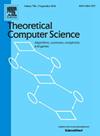Partial permutations comparison, maintenance and applications
IF 1
4区 计算机科学
Q3 COMPUTER SCIENCE, THEORY & METHODS
引用次数: 0
Abstract
This paper studies partial permutations and their use in algorithmic tasks. A partial permutation over Σ is a bijection mapping a subset to a subset , where ( denotes the size of a set Σ). Intuitively, two partial permutations agree if their mapping pairs do not form conflicts. We formally define this notion enabling a consistent as well as informatively rich comparison between partial permutations. We define the Partial Permutations Agreement problem (PPA), as follows. Given two sets of partial permutations over alphabet Σ, each of size n, output a pair (, where and agrees with , if exists. We study the existence of a data structure for efficiently maintaining a dynamic set of partial permutations enabling to retrieve agreement of partial permutations giving both negative and positive results. As applications we point out: (1) fruitful/futile methods for efficient genes sequences comparison in database, (2) an automatic color transformation data augmentation technique for image processing through neural networks, (3) negatively answer a recently posed open question on the strict parameterized dictionary matching with one gap (PDMOG) problem over general dictionary alphabets.
部分排列的比较、维护和应用
本文研究了部分置换及其在算法任务中的应用。部分排列在Σ是一个双射πpar:Σ1↦Σ2映射Σ子集1⊂ΣΣ子集2⊂Σ,哪里|Σ1 | = | 2 |Σ(|Σ|表示设置Σ)的大小。直观地说,如果两个部分排列的映射对不形成冲突,则它们是一致的。我们正式定义了这个概念,使部分排列之间的比较具有一致性和丰富的信息。我们定义部分排列协议问题(PPA)如下。给定两个大小为n的字母表Σ上部分排列的集合A1,A2,输出一对(πi,πj),其中πi∈A1,πj∈A2,且πi与πj一致,如果存在。我们研究了一种数据结构的存在性,这种数据结构能够有效地维护一组动态的部分排列,从而能够检索出部分排列的一致性,给出正负结果。在应用方面,我们指出:(1)有效/无效的数据库基因序列比较方法;(2)通过神经网络实现图像处理的自动颜色变换数据增强技术;(3)否定了最近提出的关于一般字典字母的严格参数化字典匹配(PDMOG)问题的开放性问题。
本文章由计算机程序翻译,如有差异,请以英文原文为准。
求助全文
约1分钟内获得全文
求助全文
来源期刊

Theoretical Computer Science
工程技术-计算机:理论方法
CiteScore
2.60
自引率
18.20%
发文量
471
审稿时长
12.6 months
期刊介绍:
Theoretical Computer Science is mathematical and abstract in spirit, but it derives its motivation from practical and everyday computation. Its aim is to understand the nature of computation and, as a consequence of this understanding, provide more efficient methodologies. All papers introducing or studying mathematical, logic and formal concepts and methods are welcome, provided that their motivation is clearly drawn from the field of computing.
 求助内容:
求助内容: 应助结果提醒方式:
应助结果提醒方式:


